Structure of java program diff c- cpp and java
- 2. Topics for Today’s Session Differences between C, C++ & Java Structure of a Java Program
- 3. Differences between C, C++ and Java Feature C C++ Java Programming Paradigm Procedural language Object-Oriented Programming (OOP) Pure Object Oriented Oriented Origin Based on assembly language Based on C language Based on C and C++ Developer Dennis Ritchie in 1972 Bjarne Stroustrup in 1979 James Gosling in 1991 Translator Compiler only Compiler only Interpreted language (Compiler + interpreter) Platform Dependency Platform Dependent Platform Dependent Platform Independent Code execution Direct Direct Executed by JVM Approach Top-down Bottom-up Bottom-up File generation .exe files .exe files .class files Pre-processor directives Support header files (#include, #define) Supported (#header, #define) Use Packages (import) keywords 32 keywords 63 keywords 50 keywords
- 4. Contd.. Feature C C++ Java Datatypes (union, structure) Supported Supported Not supported Inheritance No inheritance Supported Supported except Multiple inheritance Overloading No overloading Support Function overloading (Polymorphism) Operator overloading is not supported Pointers Supported Supported Not supported Allocation Use malloc, calloc Use new, delete Garbage collector Exception Handling Not supported Supported Supported Templates Not supported Supported Not supported Destructors No constructor neither destructor Supported Not supported Multithreading/ Interfaces Not supported Not supported Supported Database connectivity Not supported Not supported Supported Storage Classes Supported ( auto, extern ) Supported ( auto, extern ) Not supported
- 5. Structure of a Java Program
- 6. Documentation Section: It includes the comments that improve the readability of the program. It consists comments in Java that describe the purpose of the program, author name, date and time of program creation. This section is optional and comments may appear anywhere in the program. Java programming language supports three types of comments.. Single line Comment (or end-of line comment) It starts with a double slash symbol (//) and terminates at the end of the current line. Ex: // sum of two numbers Multi-line Comment /* a multi-line comment is declared like this and can have multiple lines as a comment */ Documentation Comment /** a documentation comment starts with a delimiter and ends with */
- 7. Package Statement A package is a collection of classes, interfaces and sub- packages. A sub package contains collection of classes, interfaces and sub-sub packages etc. There is a provision in Java that allows you to declare your classes in a collection called package. There can be only one package statement in a Java program. It must appear as the first statement in the source code file before any class or interface declaration. This statement is optional, Syntax: package package_name; Example: package student; This statement declares that all the classes and interfaces defined in this source file are a part of the student package. java.lang.*; package is imported by default and this package is known as default package.
- 8. Import Statement Many predefined classes are stored in packages in Java, an import statement is used to refer to the classes stored in other packages. An import statement is always written after the package statement but it has to be before any class declaration. You can import a specific class or all the classes of the package. Many classes can be imported in a single program and hence multiple import statements can be written. import java.util.Date; //imports the date class import java.applet.*; //imports all the classes from the java applet package
- 9. Interface Section This section is used to specify an interface in Java. It is an optional section which is mainly used to implement multiple inheritance in Java An interface is similar to a class but contains only constants and method declarations. An Interfaces cannot be instantiated. They can only be implemented by classes or extended by other interfaces. Interface shape{ void draw(int length, int bredth); void show(); }
- 10. Class Definition Java program may contain multiple class definition. Classes are primary feature of Java program. The classes are used to map real world problems. classes defines the information about the user-defined classes in a program. A class is a collection of variables and methods that operate on the fields. Every program in Java will have at least one class with the main method. class Addition { void add(String args[]) { int a=2, b=3, c; c=a+b; System.out.println(c); } }
- 11. Main Method Class Execution of a Java application starts from the main method. In other words, its an entry point for the class or program that starts in Java Run-time. The main () method which is from where the execution of program actually starts and follow the statements in the order specified. The main method can create objects, evaluate expressions, and invoke other methods and much more. On reaching the end of main, the program terminates and control passes back to the operating system. The class section is mandatory. // Program to display message on the screen class HelloJava { public static void main(String args[]) { System.out.println("Hello Harsha"); } }
- 12. Summary In this lesson you learnt about Java Differences between C , C++ and Java Structure of Java Program
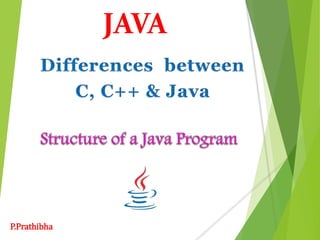
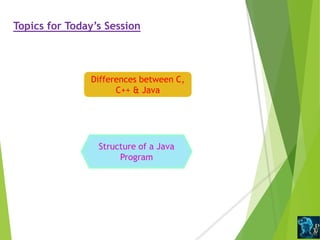
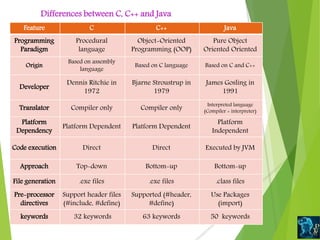
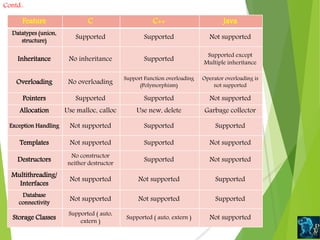
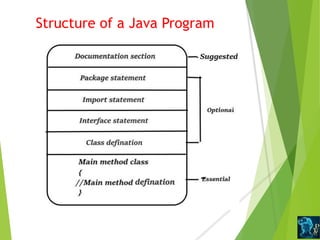

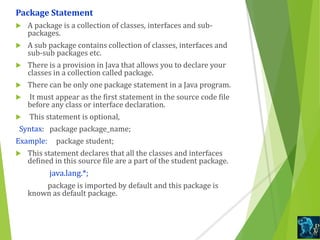
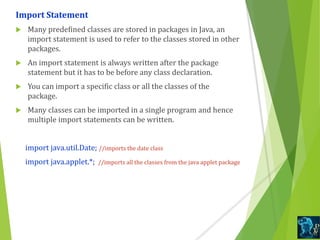

![Class Definition
Java program may contain multiple class definition.
Classes are primary feature of Java program.
The classes are used to map real world problems.
classes defines the information about the user-defined classes
in a program.
A class is a collection of variables and methods that operate on
the fields.
Every program in Java will have at least one class with the main
method.
class Addition
{
void add(String args[])
{
int a=2, b=3, c;
c=a+b;
System.out.println(c);
}
}](https://image.slidesharecdn.com/structureofjavaprogram-diffc-cppandjava-201023152718/85/Structure-of-java-program-diff-c-cpp-and-java-10-320.jpg)
![Main Method Class
Execution of a Java application starts from the main method.
In other words, its an entry point for the class or program that
starts in Java Run-time.
The main () method which is from where the execution of program
actually starts and follow the statements in the order specified.
The main method can create objects, evaluate expressions, and invoke
other methods and much more.
On reaching the end of main, the program terminates and control
passes back to the operating system.
The class section is mandatory.
// Program to display message on the screen
class HelloJava {
public static void main(String args[])
{
System.out.println("Hello Harsha");
} }](https://image.slidesharecdn.com/structureofjavaprogram-diffc-cppandjava-201023152718/85/Structure-of-java-program-diff-c-cpp-and-java-11-320.jpg)

